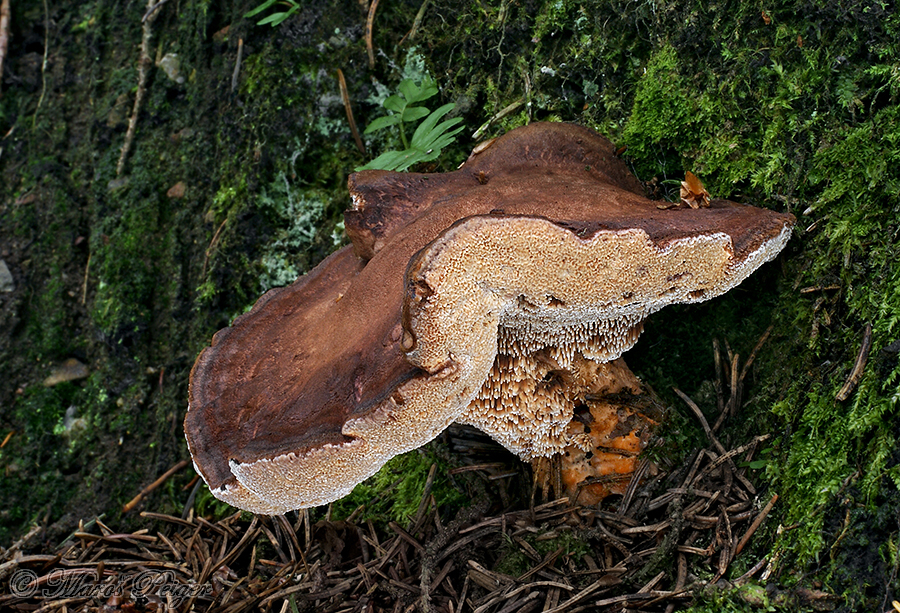- Proposed
- Under Assessment
- Preliminary Assessed
- NTAssessed
- 5Published
Sarcodon martioflavus (Snell, K.A. Harrison & H.A.C. Jacks.) Maas Geest.
- Scientific name
- Sarcodon martioflavus
- Author
- (Snell, K.A. Harrison & H.A.C. Jacks.) Maas Geest.
- Common names
 jelenkovec oranžovohnedý
jelenkovec oranžovohnedý- IUCN Specialist Group
 Mushroom, Bracket and Puffball
Mushroom, Bracket and Puffball- Kingdom
- Fungi
- Phylum
- Basidiomycota
- Class
- Agaricomycetes
- Order
- Thelephorales
- Family
- Bankeraceae
- Assessment status
- Assessed
- Preliminary Category
- NT A2c+3c+4c
- Proposed by
- Maroš Peiger
- Assessors
- Ivona Kautmanova, Tea von Bonsdorff, Armin Mešić, John Bjarne Jordal
- Editors
- Gregory Mueller, Tea von Bonsdorff, Tor Erik Brandrud
- Comments etc.
- Anders Dahlberg, Maroš Peiger
Assessment Notes
Justification
Hydnellum martioflavum is an umbrella species, found in habitats with diverse and rich funga (“hot spots”) in old undisturbed coniferous and mixed forests mostly on calacareous soils. The forests are declining mainly due to changing logging practices, development projects and pollution (airborne nitrogen deposition). The species is redlisted in most countries of its occurrence.
The decline of the major habitat of the species, Scandinavian calcareous Picea forests, in the evaluation period (last 50 years) is estimated to be in the magnitude of 15-20%. We estimate the decline of the species to be in the same magnitude. Based on this, the species becomes red-listed as NT according to the A-criterion (A2c + 3c + 4c) (species/habitat decline >15%), and likevise, the species becomes NT according to the C2a(i) criterion, due to persistent decline and small population < 20 000 individuals.
Taxonomic notes
Hydnellum martioflavum
(Snell, K.A.Harrison & H.A.C.Jacks.) E.Larss., K.H.Larss. & Kõljalg. Formally listed as a species of Sarcodon, but Sarcodon has now been placed in synonomy with Hydnellum (Larsson et al 2019)The species is described from Canada, but it´s not documented by sequencing that the species is the same in Europe and North America. He we treat the species in European sense.
Why suggested for a Global Red List Assessment?
Sarcodon martioflavus is easy to identify, rather rare species of the Bankeraceae family. It occurs in old growth coniferous forests with long term continuity and natural occurrence of spruce, with which it is forming mycorrhiza. Preferred habitats are humid, with well developed mossy layer on fertile calcareous soils (rich in minerals). Basidiomata are usually only few, occurring irregularly, mostly in cold years with above average atmospheric precipitation.
The species is threatened by inappropriate forest management, clear cutting of suitable habitats – old growth spruce forests. Further threats include air pollution and global climate change, with sudden temperature and rain fluctuations, lack of precipitation and its uneven distribution over the year, as well as drying of habitats.
Geographic range
The most numerous findings are documented from Scandinavia, in particular from Sweden, Norway and Finland. Rarely occurs in other countries of Central and Western Europe, such as Slovakia, Czech Republic, Germany and Switzerland.
Population and Trends
Hydnellum martioflavum is known from approx. 75 sites/localities in Norway, and approx. 20 in Sweden, according to data from national redlists and species database maps. The estimated population size in Scandinavia is approx. 500(-600) localities, which is equivalent to approx. 10 000(-12 000) individuals. The species is known from only very few localities in C Europe.
The decline of the major habitat of the species, Scandinavian calcareous Picea forests, in the evaluation period (last 50 years) is estimated to be in the magnitude of 15-20%. We estimate the decline of the species to be in the same magnitude. Based on this, the species becomes red-listed as NT according to the A-criterion (A2c + 3c + 4c) (species/habitat decline >15%), and likevise, the species becomes NT according to the C2a(i) criterion, due to persistent decline and small population < 20 000 individuals.
Population Trend: Stable
Habitat and Ecology
It occurs in old growth calcareous coniferous forests with long term continuity and natural occurrence of spruce (Picea abies), with which it is forming mycorrhiza. Preffered habitats are humid, with well developed mossy layer on fertile calcareous soils (rich in minerals) both on dry rigdes and along brooks. Basidiomata are usually only few, occurring irregularly, mostly in cold years with above average atmospheric precipitation. Sarcodon martioflavus is an umbrella species, found in habitats with diverse and rich mycoflora (“hot spots”).
Threats
Hydnellum martioflavum and its habitats (calcareous Picea forests) have been declining e.g. due to areal loss (urbanization, including tourist resorts, road constructions, expansion of limestone quarries) as well as decreased habitat quality/ecological conditions due to modern forestry with clear-cuttings. In Norway, which has the largest populations of H. martioflavum, calcareous Picea forests are redlisted as VU.
Conservation Actions
For the protection of Sarcodon martioflavus the strictest protected areas should be declared in the whole area of its occurrence, nature reserves is highly needed. Especially protection of small hot spots with many threatened species.
Research needed
Research should be focussed on population dynamics of this long-lived slowly evolving species and on habitat conditions.
Use and Trade
Bibliography
DVOŘÁK, D., HROUDA, P. 2005. Ježaté houby / lošáky a korálovce. Brno: Masarykova univerzita v Brně, 2005. p. 1-36.
KŘÍŽ, M. 2017. Sarcodon martioflavus in the Czech Republic, p. 33 – 40 In: Mykologicke listy, Praha, no. 136, 2017.
NITARE, J., HÖGBERG, N. 2012. Svensk Mykologisk Tidskrift 33 (3). Göteborg: Göteborgs universitet, p. 2-49.
PEIGER, M., TOMKA, P., PAULÍNY, M. 2015. Huby Liptova. Liptovské múzeum v Ružomberku, p. 1- 168.
PEIGER, M. 2015. Vybraní zástupcovia jelenkovitých húb (Bankeraceae), ich ekológia a indikačná hodnota v lesných ekosystémoch. Liptovský Mikuláš, p. 1-67.
Country occurrence
Regional Population and Trends
| Country | Trend | Redlisted |
|---|

